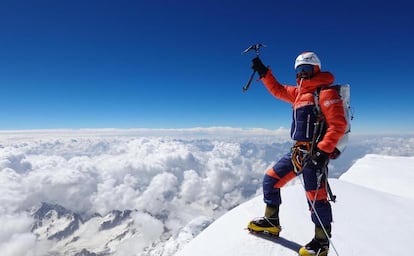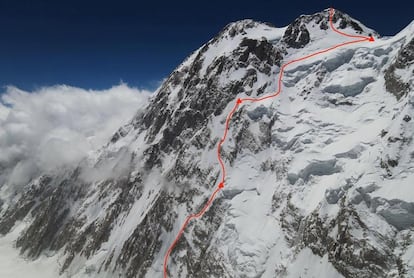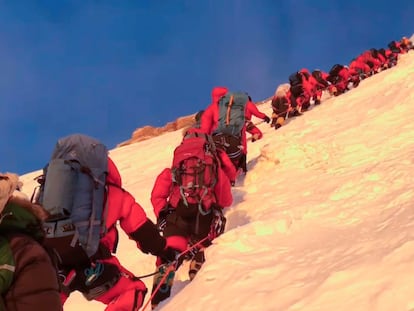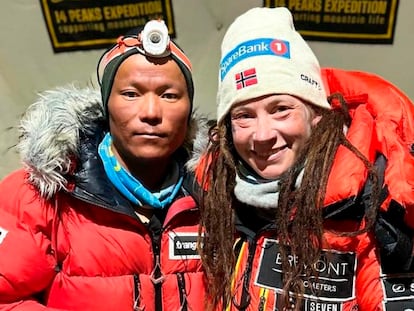Kazuya Hiraide, the best mountaineer of the 21st century who is unknown in the West
The Japanese citizen, who may be on his way to collecting his fourth Piolet d’Or mountaineering award, has announced that he will take on the formidable and brutal west face of K2

The most special mountaineer of the 21st century had no sponsor. And, when he finally found one, the man who promised to support his career passed away shortly after. Marc André Leclerc — now a mythical and global hero, whose brief life has been documented on Netflix — had no income because he didn’t have a phone. He never wanted to enter the fake showcase of social media to sell himself and his climbing feats.
The great climbers of the present are divided into two groups: those who get paid to continue climbing… and those who work to be able to climb. There are those who live to feed their legion of followers, versus those who grudgingly agree to sponsorships in order to pursue big dreams.
“It’s very surprising to see how easily those climbers, who have the backing of big sponsors, abandon expeditions,” jokes Marc Toralles, a mountain climber from Catalonia, Spain. At a time when safety is fashionable, dying on a mountain is the worst possible publicity for a sponsor… even if it sells adventure as a way of life.
If we had to point out another exemplary mountaineer from this century, it would be the Japanese Kazuya Hiraide, who is almost unknown to the Western public. Despite having won three Piolet d’Or mountaineering awards, he earns his living by working for a sports equipment distributor. A few weeks ago he returned from Tirich Mir — a 25,000-foot-tall mountain in Pakistan — having charted a new route through the unknown north face. This could earn him his fourth Piolet d’Or. His friend and alpine partner, Kenro Nakajima, would earn his third.

Hiraide isn’t sponsored by any of the large global mountain equipment firms. The athletes on their payroll are able to dedicate themselves to training and completing feats. Hiraide’s sponsor is Ternua, an outdoor sporting store from the Basque Country in northern Spain. While Ternua provides Hiraide with clothing and equipment, it cannot afford to pay him a salary. It’s as if Mbappé played for Paris Saint-Germain simply for the love of the sport. While you would think that other firms in the mountaineering world could offer more to the Japanese athlete, the marketing strategies of mountain equipment manufacturers are often incomprehensible.
Many paid mountaineers, climbers or mountain runners spend half their lives pondering how to improve their presence on social media. However, such activities are suspicious: if you always have your eyes glued to your mobile, it’s difficult to reach the level of Hiraide, a master in the field. Social media is incompatible with the art of exploring mountains, looking for sources of inspiration, charting unexpected paths, or going where no one has gone before.
The example of Hiraide is that of an explorer. He’s reminiscent of George Leigh Mallory, the British mountaineer who participated in expeditions on Mount Everest in the 1920s. To climb the north face of Tirich Mir, it was first necessary for Hiraide to harness this instinct.
“That slope was protected by a virtual fortress of peaks, glaciers and walls. To find it, we had to reach a pass at [20,300 feet above the valley], confirm that it wouldn’t be possible to go down to the glacier that stretched out at our feet, go back and find the start of the route, all after a detour that took us two days. I love exploration!” Hiraide said.
All the mental strength that Hiraide exhibits — his desire to open himself up to failure and his need to live a life of adventure away from the exaggeration of social media — doesn’t exactly translate into physical strength. “In fact,” explains Alberto Iñurrategi, also a Himalayan climber, now in charge of the Ternua mountaineering team, “Kazuya climbs very, very little on rock. His amputated toes barely allow him to move freely… but when it comes to tackling icy and mixed terrains at high altitude, few can rival him.” And, as if his sincere commitment to the activity wasn’t enough, even Hiraide’s ice axes are from another era. Of course, as has been demonstrated by several Tour de France champions such as Tadej Pogačar and Miguel Induráin it’s not about the bike you have, but how hard you pedal.
A few months ago, while visiting Spain, Hiraide, reflecting on his life, realized that he was approaching the age of 50… an almost impassable border for high-level mountaineering. “I know I don’t have many years left before I retire, but I’m hoping to do something big,” he whispers. Something bigger than all the mountains that he’s already climbed? “Yes, I have a dream… but it seems too soon to talk about it. Although I can say that it will be the west face of K2,” he says, with the most sincere of smiles.
A few days ago, Hiraide gathered his country’s specialized media outlets together, explaining the details of his expedition to Tirich Mir. He also revealed his next (and possibly final?) challenge: the west face of K2, the second-highest mountain in the world after Mount Everest. Located in the Karakoram mountain range in the Kashmir region, which spans the borders of Pakistan, China, and India, it is 28,251 feet high. The undertaking of such a feat seems to be an insane challenge.
Hiraide suffered greatly from the loss of his regular teammate, the mountaineer Kei Taniguchi, who died in 2015 in a mountain accident. Together with her, he got his first Piolet d’Or, while Taniguchi became the first (and only) woman to be awarded one. Their success took place in 2008, after they climbed the southwest face of Kamet, the 25,446-foot mountain peak in the Himalayas.
“I have never met anyone with that ability to dream, with that desire to never give up in the face of a challenge. Kei was special… it was very difficult for me to find a rope partner [after her death] at that height,” Hiraide laments. His current teammate, Kenro Nakajima, is 10 years younger than Hiraide, who declares himself to be his mentor: “If I can teach him what’s necessary so that he doesn’t kill himself, so that his youth doesn’t betray him, I will have done something good,” he explained a few months ago.
Next summer, the formidable west face of K2 — a mountain that causes the soul to shrink — will see two ants approaching with their mountaineering clothes on; two wills determined to climb, as if the challenge is simply an ordinary peak. They will want to go up and down safely and securely, without leaving any trace that they were there. Perhaps there will be a permanent trace in their memories, but not one of their footprints will be shared on Instagram.
Sign up for our weekly newsletter to get more English-language news coverage from EL PAÍS USA Edition
Tu suscripción se está usando en otro dispositivo
¿Quieres añadir otro usuario a tu suscripción?
Si continúas leyendo en este dispositivo, no se podrá leer en el otro.
FlechaTu suscripción se está usando en otro dispositivo y solo puedes acceder a EL PAÍS desde un dispositivo a la vez.
Si quieres compartir tu cuenta, cambia tu suscripción a la modalidad Premium, así podrás añadir otro usuario. Cada uno accederá con su propia cuenta de email, lo que os permitirá personalizar vuestra experiencia en EL PAÍS.
¿Tienes una suscripción de empresa? Accede aquí para contratar más cuentas.
En el caso de no saber quién está usando tu cuenta, te recomendamos cambiar tu contraseña aquí.
Si decides continuar compartiendo tu cuenta, este mensaje se mostrará en tu dispositivo y en el de la otra persona que está usando tu cuenta de forma indefinida, afectando a tu experiencia de lectura. Puedes consultar aquí los términos y condiciones de la suscripción digital.
More information
Archived In
Últimas noticias
Maduro pleads not guilty before the federal court in New York: ‘I am still the president of Venezuela’
A new test can detect Alzheimer’s from a finger prick
UN team enters Sudanese city of El Fasher after paramilitary massacre: ‘It’s like a ghost town’
A recipe for resistance: Indigenous peoples politicize their struggles from the kitchen
Most viewed
- Gilles Lipovetsky: ‘If you want to live better and fall in love, take Prozac, don’t look to philosophy’
- Alain Aspect, Nobel laureate in physics: ‘Einstein was so smart that he would have had to recognize quantum entanglement’
- Alvin Hellerstein, a 92-year-old judge appointed by Bill Clinton, to preside over Maduro’s trial in New York
- Why oil has been at the center of Venezuela-US conflicts for decades
- Maduro’s downfall puts China’s relationship with Venezuela to the test











































